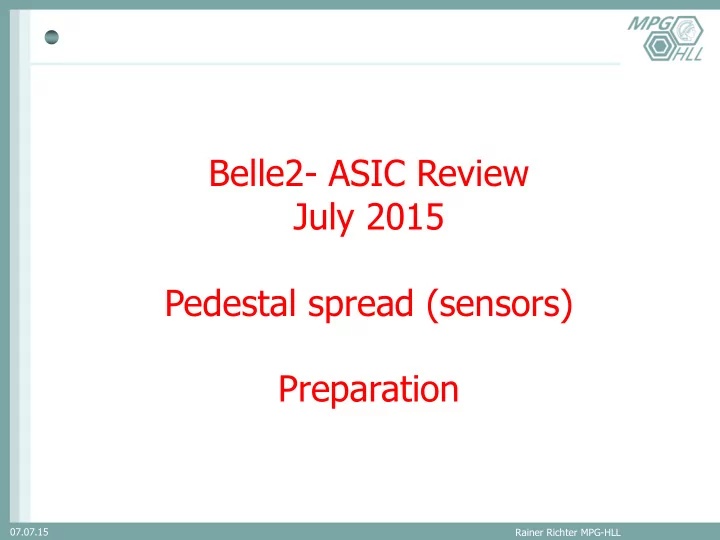

Belle2- ASIC Review July 2015 Pedestal spread (sensors) Preparation 07.07.15 Rainer Richter MPG-HLL
PXD6 results
768 Depfets – Big Matrix I00 first row
Possible reasons for pedestal variations A) Parasitic Source resistors (gap between Source implant and active channel) (repaired in PXD9: see last Seeon talk) B) Gate length (litho, etching) B) Threshold voltage (Implantation, gate oxide thickness, Vfb) C) Bad channels (poly etch relicts during implantations)
A) Parasitic Source resistor VG = -3V, VD= -3V Implant before oxidation before Ox. after Ox. Id = 113 µA 10 18 10 17 10 18 Id = 103 µA 10 17 before oxidation + optimized Id = 114,5 µA implantation 10 18 parameter 10 17 R. H. Richter, HLL
B) Gate length variation – measured at PXD9-3 Wafer 28
PXD9-3 W28 OF2
C) Bad Channels: Implantation through poly etch relichts Shallow p implant (PXD6) Shallow p implant (PXD9) After etching After removal After nitride etch
D) Implantation dose variations In the DEPFET channel: 2 subtracting doses: Internal Gate + shallow p (threshold adjustment) in the range of 10^12cm-2 Implanter specification: < 0.5% (rms), measured 0.3% 2 x 0.5% = 1% corresponds to 10^10cm-2 dose variation PXD9: -> thresh. variation 40mV -> 3µA @gm=75µS (Vgs=-3V)
Drain currents PXD9 - W35 (22000,12000 pixel) 𝑊 𝐻 = −3 𝑊, 𝑊 𝐸𝑇 = −5 𝑊 Average current [-µA] pedestal spread [µA] (2 σ ) Threshold voltage [V] 𝑊 𝐵𝐷 = 15 𝑊, 𝑊 𝐷𝐻 = 5 𝑊 OF1 OF2 OF1 OF2 OF1 OF2 switcher1 gaterow1 121 114 21 (7) 17 (6) 0,051 -0,016 switcher1 gaterow2 119 113 16 (6) 17 (5) 0,039 -0,020 switcher2 gaterow1 127 122 20 (8) 23 (9) 0,093 0,055 switcher2 gaterow2 126 123 22 (8) 24 (9) 0,098 0,061 switcher2 gaterow3 124 - 13 (5) - 0,081 - switcher2 gaterow4 123 - 15 (6) - 0,073 - switcher3 gaterow1 119 123 15 (5) 18 (6) 0,025 0,059 switcher3 gaterow2 120 123 17 (5) 16 (5) 0,029 0,057 switcher3 gaterow3 120 - 16 (6) - 0,026 - switcher3 gaterow4 121 - 17 (6) - 0,054 - switcher4 gaterow1 125 124 19 (7) 25 (10) 0,102 0,081 switcher4 gaterow2 124 124 15 (5) 16 (5) 0,095 0,085 switcher4 gaterow3 124 - 13 (5) - 0,093 - switcher4 gaterow4 125 - 15 (6) - 0,102 - switcher5 gaterow1 122 120 19 (7) 23 (7) 0,090 0,097 switcher5 gaterow2 122 120 14 (5) 14 (5) 0,087 0,061 switcher5 gaterow3 123 - 16 (5) - 0,109 - switcher5 gaterow4 121 - 17 (6) - 0,090 - switcher6 gaterow1 122 120 15 (5) 19 (6) 0,074 0,055 switcher6 gaterow2 120 120 17 (6) 15 (5) 0,058 0,050 switcher6 gaterow3 122 - 15 (6) - 0,076 - switcher6 gaterow4 121 - 17 (6) - 0,067 - 120,50 16,5 (6,0) 18,9 (6,5) 0,073 0,052 Total average 122,3
Implications (ii) Yield lesson from PXD6: Relaxing the topology Clear line must run parallel to Source -> asymmetric Source contact Sheet resistance 300Ohm/sq. (3x lower than in the old technology due to better implant activation) Estimation: @Id=80µA, gm=50µS -> D I ≈ 4µA We will see an odd-even behavior but no change with radiation R. H. Richter, HLL
Recommend
More recommend